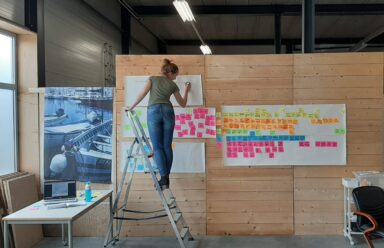
The promise of Customer Experience: Ambition vs. Reality
There is a big difference between the ambition and the reality of Customer Experience (CX) design. Many companies have the right motivation and ambition to improve their CX, but in practice the actual improvement often turns out to be disappointing. Especially in the higher regions of a company, the CX strategy is sometimes put aside. It is not always done what must be done to realize the ambition. In this article we show with a number of examples the difference between ambition and reality, and we share our vision how you can make your ambition become reality.
Customer Experience: how do you do that?
When speaking with companies about what the CX strategy should be in relation to the business strategy, you notice that they know well where they want to go with the company and what the CX should be. However, the steps needed to improve in the CX area are not always clear.
Usually, a company-wide strategy is developed in which CX has a role. However, the feasibility of this part proves more difficult than anticipated and is often underestimated. For example, companies do provide budget for a large website project, but it is not taken care of that this website can be further developed after launch and that it can really deliver its value weekly.
Customer Experience remains a black box
CX design remains something elusive and a real black box. Companies that have just started or are less then a few decades old, are remarkably better at improving and maintaining their CX. They have shown to be able to make a good CX part of their DNA.
In the related podcast (in Dutch) we cited an example of a plantcompany, Plantsome. This company distinguishes itself by putting extra effort into their CX. They are very focused on helping people and want every interaction with them to be pleasant. If something goes wrong, they bet that the conversation will still be a fun and positive conversation. Negative emotions are neutralized and converted into positive emotions. Suppose an incorrect plant pot is delivered and you approach their customer service for this, then the employee has no script in front of him. They are trained to solve situations as well as possible, with a mandate to make choices. This ensures a more pleasant interaction and solves problems immediately.
A good CX can sometimes also be motivated by an individual. For example, we gave the example of a reception employee in our environment who does everything possible to receive customers well and give them a good experience. With this, she has a major impact within the company. She receives people at the desk and answers the phone with the will to let that experience be as good as possible. She has coordinated and set this up with her colleagues herself without directions from the company.
Why is the ambition for Customer Experience declining?
Young companies usually start with a healthy and achievable ambition for their CX. At that time they are still in a start-up phase, so that ambition is still at the top of the priority list. When a company becomes more mature and they grow, it is often more difficult to keep the priority on CX the same and to keep involving employees on a larger scale to maintain a good CX.
Tesla
Take Tesla as an example: they have had so much success with their latest model, the Model 3, that they have a very large share of the car fleet in the Netherlands. They previously had success with the Model S and Model X, but the scale was very different. With the first two models, they were able to meet the demand with five Tesla workshops spread across the Netherlands. However, these are now under greater pressure. All Model 3 drivers must also be assisted.
The service in the workshop has remained the same, every customer is still king. However, getting on the radar at a car workplace has changed. The workshop phone number is no longer active, all communication must happen via the Tesla app. This offers advantages compared to other car dealers. After all, you can schedule your appointment yourself at any time via the app. However, it also has disadvantages. It is not possible to check how things are going with your car; something that is no more than normal with any other car brand.
Apple
Apple is known for an excellent product experience. Their products are liked by many people, and some people are so convinced of the quality that they only buy their technology from this brand. Apple’s buying experience through their website or physical stores is also very good. However, the delivery experience is not as good. And this experience also counts. If your delivery service is so inflexible that you prefer to order the same products from another store, this will also reflect on your own CX. CX is not only about your own products and channels, but also about the partners you work with.
Causes of a broken Customer Experience
What can break a customer experience? In the podcast we discussed this example: a company we know consists of 8 different business departments, each of which is managed separately as separate companies. Every company has its own director, who can and should go his own way. Outwardly, however, they form one company.
This company wanted a new website: useful for new customers, because all 8 companies would be represented on it and jointly offer their services. The goal of the new site was to present themselves as one company and improve the CX.
How was this possible?
The long-game
This brings us to one of the most important points of a CX strategy: the long term. Improving CX is not a quick fix. It is something that needs to be improved in the long term and needs constant attention. CX is not a one-time thing to do, it’s a thought that should last through the entire existence of a company. It is not a one-off project, it is a constant process.
Therein lies a problem for many companies. Communication within companies does not go as smooth everywhere, while the improvement of CX would go beter if the entire company is involved. It works best if you not only make the business strategy communicable, but also have that strategy embraced within the organization, so that everyone can participate and know what role he or she has in this.
Customer Experience works cross-department
CX is therefore not the responsibility of one specific department. The entire company plays an important role in this.
One weak link can therefore collapse the entire experience. CX is more than just contact with the customer; you should be busy with this in all possible areas.
Some percentages
Research shows that if customers have had a bad experience, 22% of them will spend less and 19% will immediately stop making further purchases from that company. 30% tells this to the company and 50% tell their friends. 15% leave a complaint on a review site. So one bad experience has a big impact on your reputation and sales. It starts a snowball effect.
On the other hand, if people have a good experience, they are three to four times more willing to buy something and more often give a good review.
A good solution
If we look at all these examples, the solution is not to bet on a one-off improvement, but that you start thinking in terms of evolution and long-game. That you are able to bridge departments, make your strategy shareable and that it is embraced throughout the entire company. Everyone can and must contribute.
 Jeroen Grit
Jeroen Grit 

